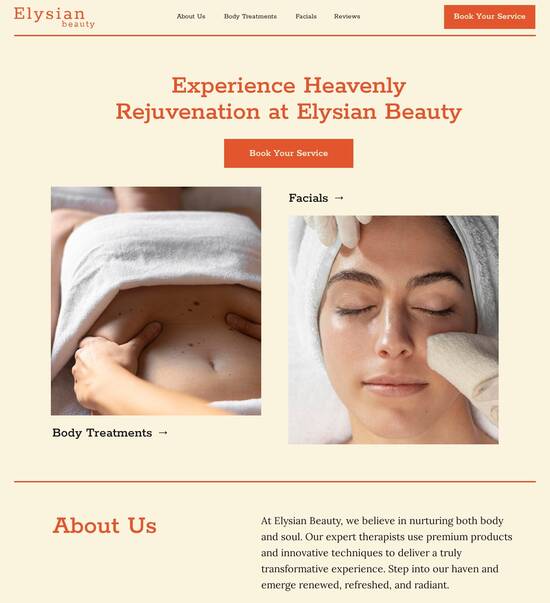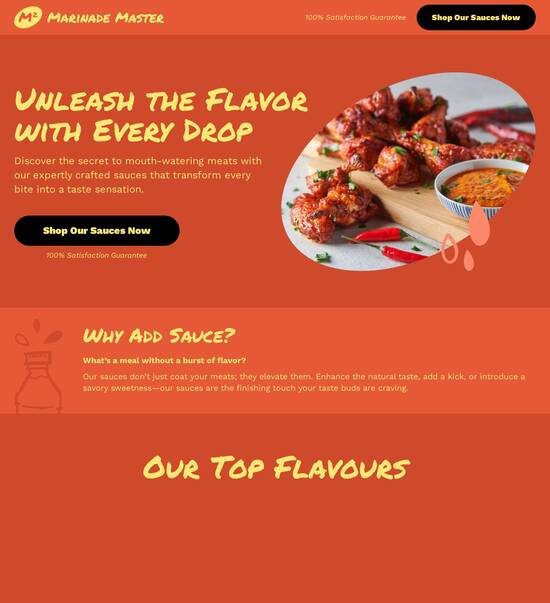
Data-driven value proposition page template
Explore Similar TemplatesAbout template
Unleash your creativity with the data-driven value proposition page template. Try Instapage today.
Recommended templates

Easy to build without coding
With the intuitive drag-and-drop builder, anyone on your team can create high-converting pages without any knowledge of code or design. Make enhancements to your landing page with custom widgets using Javascript, HTML/CSS, or third-party scripts.

Multiple layouts for any industry and goal
Select from 500+ landing page layouts built to boost conversions across industry-specific scenarios. Customize them by adjusting fonts, adding images, and generating on-brand content with the AI assistant. Quickly scale with Instablocks® and Global Blocks that you can save, reuse, and update globally.

Loads fast and looks polished on any device
Every template is responsive, which means they present professionally on any device and load blazingly fast with our Thor Render Engine. You can also power them up with Google AMP technology to deliver an unparalleled mobile experience and drive higher conversions.

Robust analytics & experimentation
Get real-time updates and reporting across all your devices, showing the number of visitors, conversions, cost-per-visitor, and cost-per-lead. Launch AI-powered experiments, run A/B tests, and use heatmaps to analyze user behavior, then optimize your landing page to maximize conversions.







Easy to build without coding
With the intuitive drag-and-drop builder, anyone on your team can create high-converting pages without any knowledge of code or design. Make enhancements to your landing page with custom widgets using Javascript, HTML/CSS, or third-party scripts.
Multiple layouts for any industry and goal
Select from 500+ landing page layouts built to boost conversions across industry-specific scenarios. Customize them by adjusting fonts, adding images, and generating on-brand content with the AI assistant. Quickly scale with Instablocks® and Global Blocks that you can save, reuse, and update globally.
Loads fast and looks polished on any device
Every template is responsive, which means they present professionally on any device and load blazingly fast with our Thor Render Engine.
Robust analytics & experimentation
Get real-time updates and reporting across all your devices, showing the number of visitors, conversions, cost-per-visitor, and cost-per-lead. Launch AI-powered experiments, run A/B tests, and use heatmaps to analyze user behavior, then optimize your landing page to maximize conversions.
All the features you need to build lead-generating landing pages
Explore more featuresLearn how to build top-performing landing pages for any goal
FAQs
Leading the way in building high-performing landing pages





A step-by-step guide to using Instapage for effective landing page optimization
Instapage stands out as a leading platform for creating high-converting landing pages. By leveraging its powerful features and user-friendly interface, marketers can streamline their digital marketing efforts and enhance ROI. This guide walks you through the essential steps to optimize landing pages, ensuring that your campaigns can effectively engage audiences across various sectors, including Business Services, Education, and Financial Services.
Understanding Instapage's unique offerings
With an extensive library of over 100 conversion-focused templates and lead generation elements, Instapage is tailored to meet the needs of marketers in diverse industries. Users can build landing pages without needing coding skills, making it accessible no matter the team size. This section will explore how these features can enhance your marketing strategy.
- 100+ high-converting templates - Choose from dozens of designs that are pre-optimized for conversion, allowing you to launch campaigns quickly.
- Dynamic content personalization - Implement personalized experiences for different audience segments, increasing engagement and conversion rates.
- A/B testing and analytics - Use built-in tools to experiment with different designs and content strategies to determine what resonates best with your target audience.
Getting started with page creation
Building a landing page on Instapage is straightforward. First, select a template that aligns with your goals. Next, customize the content to deliver a clear value proposition to your audience. Use Instablocks to insert various elements seamlessly.
- Choose your template - Pick one that fits your campaign goals, whether it’s lead generation or product promotion.
- Customize with ease - Adjust text, images, and layout using the intuitive drag-and-drop editor.
- Integrate lead capture forms - Ensure you have forms ready to collect user details, enhancing your lead generation efforts.
Enhancing performance through optimization techniques
Once your page is live, focus on optimizing it for better performance. Analyzing user behavior via heatmaps and running A/B tests provides insights into which elements are performing well and which need adjustments.
- Use heatmaps for insights - Visualize how visitors interact with your page to identify areas of interest or confusion.
- Conduct A/B tests - Test variations of headlines, calls-to-action, and images to see what resonates best with users.
- Monitor analytics dashboards - Regularly check performance analytics to inform future marketing strategies.
By following these steps to effectively utilize Instapage, marketers can deliver targeted messages that resonate with their respective audiences.
Embarking on your landing page optimization journey with Instapage not only streamlines your processes but also accelerates your path to higher conversions. Take advantage of its robust tools for successful marketing campaigns.
Ready to elevate your digital marketing efforts? Start using Instapage today to create captivating landing pages that convert. Your success awaits!
People also ask about Data-driven value proposition page template
Data-driven value proposition page template: A comprehensive guide
Understanding the essence of a data-driven value proposition page template
Creating a value proposition page that resonates with your audience is essential in driving conversions. A data-driven approach to crafting these pages ensures that your message is not only clear but also backed by insights derived from actual customer behavior and preferences. In this article, we'll explore the various components involved in building a compelling data-driven value proposition page template, highlighting its significance in today's competitive marketing landscape.
The framework of a value proposition page
At its core, a value proposition defines what makes your product or service unique and why customers should choose you over competitors. It encapsulates the primary value your offering delivers, positioning it as a solution to the customer’s pain points. For marketers, articulating a clear and compelling value proposition is critical, as it shapes how potential customers perceive your brand and influences their decision-making process.
Headline: The first text that captures attention, often stating the core benefit or unique feature.
Subheadline: Provides a brief elaboration on the headline, drawing in readers to learn more.
Body copy: Supports and builds on the main message, providing more in-depth information about offerings.
Visual elements: Certain colors, fonts, and images can enhance the message and engagement levels.
Integrating data-driven insights
Data plays a pivotal role in shaping effective value propositions. By leveraging analytics, marketers can uncover customer pain points, preferences, and behaviors. This information is invaluable when tailoring messages that genuinely resonate with the target audience. For instance, you might discover through data analysis that customers prioritize speed and efficiency in your service. This insight allows you to emphasize those attributes in your value proposition.
Moreover, conducting A/B testing can validate the effectiveness of various value proposition statements. With different versions of your page, you can assess which one leads to higher engagement and conversion rates. This iterative process ensures your messaging evolves based on real user feedback rather than assumptions.
Web analytics: Tools like Google Analytics help track user behavior on your website.
Customer surveys: Gathering feedback directly from users provides qualitative insights.
Feedback mechanisms: Chatbots and comment sections can capture on-the-spot customer opinions.
Social media data: Analyzing engagement on platforms like Twitter and Facebook reveals audience preferences.
Crafting compelling value proposition statements
The anatomy of an effective value proposition statement lies in its clarity, relevance, and uniqueness. A clear message ensures potential customers immediately grasp the offering. Relevance means that the proposition aligns well with what customers are genuinely looking for, while uniqueness sets your brand apart from competitors. This triad is essential for capturing attention and converting visitors into customers.
Different audiences require tailored value propositions. Adapting language and tone to fit specific demographics can resonate better. For instance, a B2B company may need formal language, while a B2C brand can adopt a more casual tone. Customizing your value propositions for various segments strengthens their impact and nurtures customer relationships.
Visual design elements: Enhancing engagement and comprehension
The science of color plays a significant role in value proposition design. Color psychology suggests that different colors evoke various emotions; for instance, blue often conveys trust, while red can spark urgency. Strategically using colors to highlight key messages can enhance user engagement and drive action.
It's not only about color; font design also significantly affects readability and user experience. Font size and weight should be chosen carefully to ensure legibility. Additionally, balancing line height helps improve reading flow, which is crucial in retaining visitors' attention on your value proposition page.
Benchmarking against competitors
When crafting your value proposition, analyzing competitor pages can provide valuable insights. Identifying best practices in the industry can guide your design and messaging approach. Conducting a SWOT analysis helps you understand your position relative to competitors and uncover areas for improvement.
Identify best practices: Look at what successful competitors are doing right.
Conduct SWOT analysis: Understand the strengths and weaknesses of your competitors.
Highlight USPs: Ensure your value proposition clearly communicates what sets you apart.
Avoid common pitfalls: Learn from competitor mistakes, ensuring your page is user-friendly.
Utilizing the value proposition canvas
The Value Proposition Canvas framework is a powerful tool for visualizing and aligning customer needs and your offering. It consists of two main components: the customer profile and the value map. The customer profile details the job, pains, and gains from the customer’s perspective, while the value map outlines your product’s features, benefits, and gains that correlate with those customer needs.
Implementing this canvas involves collaborative efforts among team members to accurately map customer insights. Regularly refining your value propositions based on these insights will ensure they remain relevant and compelling. Engaging in this iterative refinement process can lead to stronger alignment with customer expectations.
Customer-centric value proposition strategies
Understanding customer needs is essential for developing effective value propositions. Segmenting your audience allows for tailored propositions that resonate with specific groups while promoting engagement through personalized messaging. Addressing customer expectations can significantly elevate the perceived value of your offering.
Success is also measurable. Developing key performance indicators (KPIs) to track the impact of your value propositions will help you make data-driven decisions. Regularly adjusting your strategies based on these results can ensure that your marketing efforts remain effective and aligned with customer preferences.
Pricing and value perception
Pricing strategies should be seamlessly integrated into your value proposition statements. It’s essential to convey value beyond the mere price tag. Justifying the cost by highlighting the benefits and unique features reassures customers that they are making a wise investment.
Additionally, creating a perception of value through packaging and positioning is crucial. Clearly illustrating value in marketing materials can significantly influence customer decision-making. Companies like Apple have successfully navigated the price vs value concept, showing that well-conceived packaging can reinforce customer perceptions and drive sales.
Real-world applications and case studies
Several companies highlight the success of data-driven value proposition pages. These case studies provide insights into effective strategies and common pitfalls. Notable corporations have leveraged their value propositions backed by compelling data, resulting in improved conversion rates and customer loyalty.
Company A: Utilized customer feedback to revise their value proposition, boosting engagement.
Company B: Emphasized unique features through A/B testing, increasing conversion rates by 30%.
Company C: Tailored messaging for different audiences, enhancing relevance and connection.
Industry-specific strategies: Knowledge of sector regulations helped create informed messaging.
Future trends in value proposition development
As the digital landscape evolves, the development of data-driven landing pages continues to innovate. Anticipated advancements in data analytics and personalization will shape how marketers approach value proposition design. The potential integration of AI into marketing strategies presents new possibilities for crafting more personalized user experiences.
Organizations must be adaptive, preparing for a constantly changing marketing environment. Staying ahead of trends will involve continuous learning and refining based on customer feedback. Embracing these strategies will ensure that value propositions remain compelling and effective.
Closing thoughts on the impact of data-driven value propositions
In summary, the transformative power of a data-driven value proposition page template cannot be overstated. By encouraging a mindset centered on data, marketers can create more relevant and engaging experiences for their audiences. The future of landing page optimization relies heavily on utilizing customer insights to design propositions that truly stand out within a competitive landscape.
Ready to skyrocket conversions?
Supercharge your ad campaigns with high-performing landing pages
Get started














